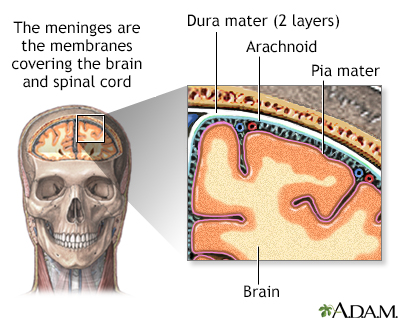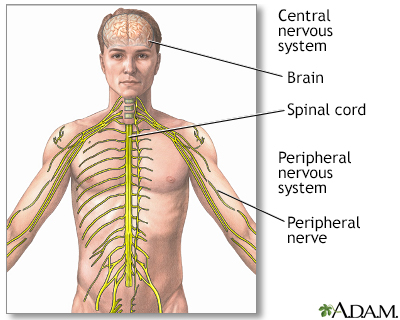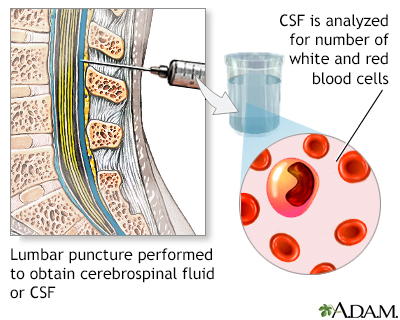Staphylococcal meningitis
Meningitis is an infection of the membranes covering the brain and spinal cord. This covering is called the meninges.
Meningitis
Meningitis is an infection of the membranes covering the brain and spinal cord. This covering is called the meninges.

Bacteria are one type of germ that may cause meningitis. The staphylococcal bacteria are one type of bacteria that cause meningitis.
Causes
Staphylococcal meningitis is caused by staphylococcus bacteria. When it is caused by Staphylococcus aureus or Staphylococcus epidermidis bacteria, it usually develops as a complication of surgery or as an infection that spreads through the blood from another site.
Risk factors include:
- Infections of heart valves
- Past infection of the brain
- Past meningitis due to spinal fluid shunts
- Recent brain surgery
- The presence of a spinal fluid shunt
- Trauma
- Bloodstream infection with Staphylococcus aureus
Symptoms
Symptoms may come on quickly, and include:
- Fever and chills
- Mental status changes
Mental status changes
Confusion is the inability to think as clearly or quickly as you normally do. You may feel disoriented and have difficulty paying attention, remembe...
 ImageRead Article Now Book Mark Article
ImageRead Article Now Book Mark Article - Nausea and vomiting
- Sensitivity to light (photophobia)
- Severe headache
- Stiff neck (meningismus)
Other symptoms that can occur with this disease:
- Agitation
Agitation
Agitation is an unpleasant state of extreme arousal. An agitated person may feel stirred up, excited, tense, confused, or irritable.
Read Article Now Book Mark Article - Bulging fontanelles in infants
Bulging fontanelles
A bulging fontanelle is an outward curving of an infant's soft spot (fontanelle).
 ImageRead Article Now Book Mark Article
ImageRead Article Now Book Mark Article - Decreased alertness
- Poor feeding or irritability in children
- Rapid breathing
Rapid breathing
A normal breathing rate for an adult at rest is 12 to 20 breaths per minute. For an infant, a normal rate is 30 to 60 breaths per minute. Tachypnea ...
 ImageRead Article Now Book Mark Article
ImageRead Article Now Book Mark Article - Unusual posture, with the head and neck arched backwards (opisthotonos)
Opisthotonos
Opisthotonos is a condition in which a person holds their body in an abnormal position. The person is usually rigid and arches their back, with thei...
 ImageRead Article Now Book Mark Article
ImageRead Article Now Book Mark Article
Exams and Tests
Your health care provider will perform a physical exam. Questions will focus on symptoms and risk factors.
If your provider thinks meningitis is possible, a lumbar puncture (spinal tap) is done to remove a sample of spinal fluid for testing. If you have a spinal fluid shunt, the sample may be taken from this instead.
Spinal tap
Cerebrospinal fluid (CSF) collection is a test to look at the fluid that surrounds the brain and spinal cord. CSF acts as a cushion, protecting the b...

Tests may include:
- Blood culture
Blood culture
A blood culture is a laboratory test to check for bacteria or other germs in a blood sample.
 ImageRead Article Now Book Mark Article
ImageRead Article Now Book Mark Article - Chest x-ray
Chest x-ray
A chest x-ray is an x-ray of the chest, lungs, heart, large arteries, ribs, and diaphragm.
 ImageRead Article Now Book Mark Article
ImageRead Article Now Book Mark Article - CT scan of the head
CT scan of the head
A head computed tomography (CT) scan uses many x-rays to create pictures of the head, including the skull, brain, eye sockets, and sinuses.
 ImageRead Article Now Book Mark Article
ImageRead Article Now Book Mark Article - Complete blood count (CBC)
Complete blood count
A complete blood count (CBC) test measures the following:The number of white blood cells (WBC count)The number of red blood cells (RBC count)The numb...
 ImageRead Article Now Book Mark Article
ImageRead Article Now Book Mark Article - Gram stain or other special stains, and culture of the spinal fluid
Gram stain
A Gram stain is a test used to identify bacteria. It is one of the most common ways to quickly diagnose bacterial infection in the body.
 ImageRead Article Now Book Mark Article
ImageRead Article Now Book Mark ArticleCulture of the spinal fluid
A cerebrospinal fluid (CSF) culture is a lab test to look for bacteria, fungi, and viruses in the fluid that moves in the space around the spinal cor...
 ImageRead Article Now Book Mark Article
ImageRead Article Now Book Mark Article
Treatment
Antibiotics will be started as soon as possible. Vancomycin is the first choice for suspected staphylococcal meningitis. Nafcillin is used when tests show that the bacteria are sensitive to this antibiotic.
Often, treatment will include a search for and removal of possible sources of bacteria in the body. These include shunts or artificial heart valves.
Outlook (Prognosis)
Early treatment improves the outcome. However, some people do not survive. Young children and adults over age 50 have the highest risk for death.
Staphylococcal meningitis often improves more quickly, with fewer complications, if the source of the infection is removed. The source may include shunts, hardware in joints, or artificial heart valves.
Possible Complications
Long-term complications may include:
- Brain damage
- Buildup of fluid between the skull and brain (subdural effusion)
Subdural effusion
A subdural effusion is a collection of cerebrospinal fluid (CSF) trapped between the surface of the brain and the outer lining of the brain (the dura...
Read Article Now Book Mark Article - Buildup of fluid inside the skull that leads to brain swelling (hydrocephalus)
Hydrocephalus
Hydrocephalus is a buildup of fluid inside the skull that leads to the brain pushing against the skull. Hydrocephalus means "water on the brain. "...
 ImageRead Article Now Book Mark Article
ImageRead Article Now Book Mark Article - Hearing loss
Hearing loss
Hearing loss is being partly or totally unable to hear sound in one or both ears.
 ImageRead Article Now Book Mark Article
ImageRead Article Now Book Mark Article - Seizures
Seizures
A seizure is the physical changes in behavior that occurs during an episode of specific types of abnormal electrical activity in the brain. The term ...
 ImageRead Article Now Book Mark Article
ImageRead Article Now Book Mark Article - Staph infection in another area of the body
When to Contact a Medical Professional
Call 911 or the local emergency number or go to an emergency room if you suspect meningitis in a young child who has the following symptoms:
- Feeding problems
- High-pitched cry
- Irritability
- Persistent, unexplained fever
Meningitis can quickly become a life-threatening illness.
Prevention
In high-risk people, taking antibiotics before diagnostic or surgical procedures may help reduce the risk. Discuss this with your provider.
Reviewed By
Jatin M. Vyas, MD, PhD, Professor in Medicine, Harvard Medical School; Associate in Medicine, Division of Infectious Disease, Department of Medicine, Massachusetts General Hospital, Boston, MA. Also reviewed by David C. Dugdale, MD, Medical Director, Brenda Conaway, Editorial Director, and the A.D.A.M. Editorial team.
Centers for Disease Control and Prevention website. Meningitis. About bacterial meningitis. www.cdc.gov/meningitis/about/bacterial-meningitis.html. Updated January 9, 2024. Accessed September 10, 2024.
Hasbun R, Van de Beek D, Brouwer MC, Tunkel AR. Acute meningitis. In: Bennett JE, Dolin R, Blaser MJ, eds. Mandell, Douglas, and Bennett's Principles and Practice of Infectious Diseases. 9th ed. Philadelphia, PA: Elsevier; 2020:chap 87.
Nath A. Meningitis: bacterial, viral, and other. In: Goldman L, Cooney KA, eds. Goldman-Cecil Medicine. 27th ed. Philadelphia, PA: Elsevier; 2024:chap 381.





 All rights reserved.
All rights reserved.